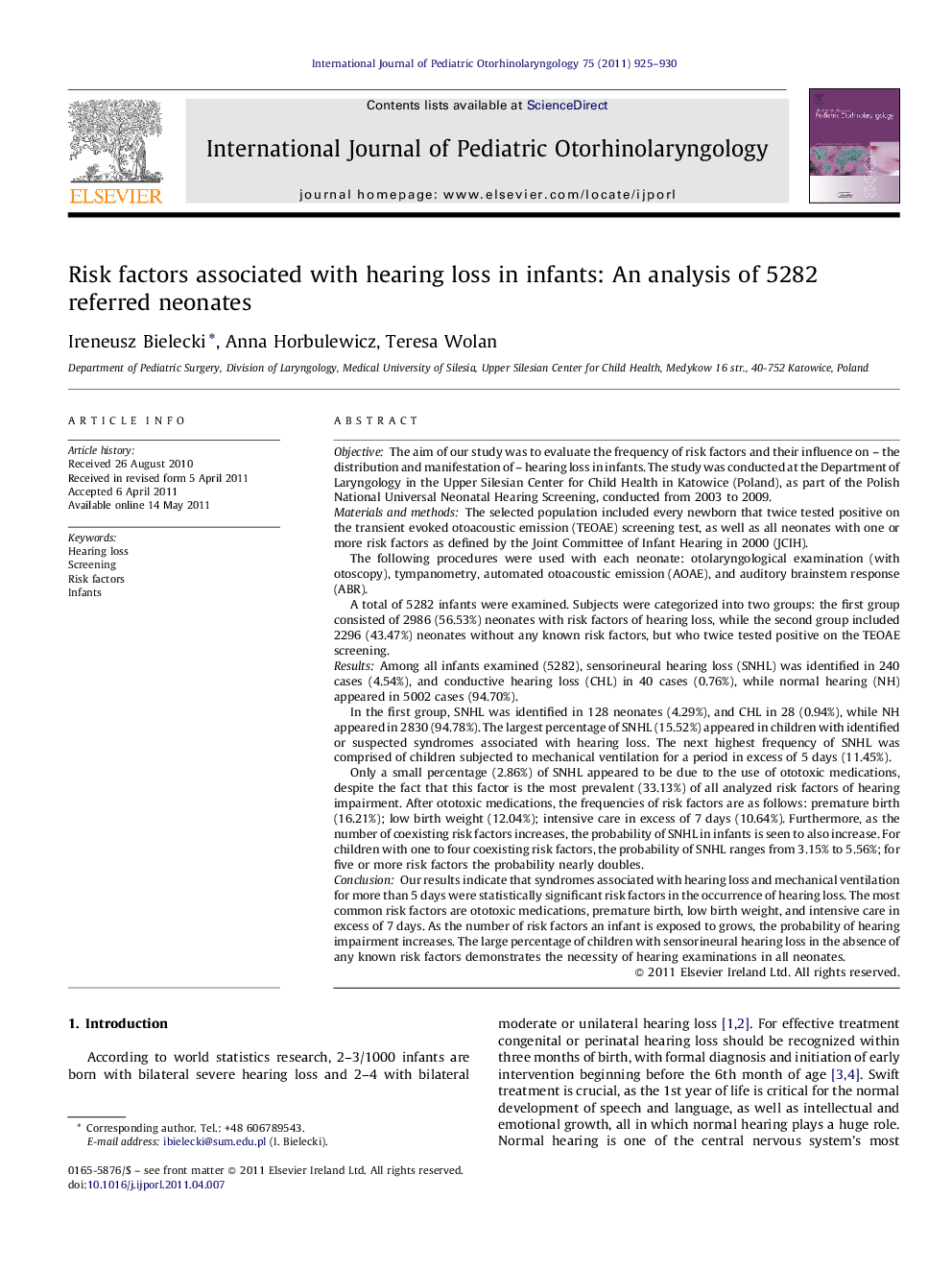| کد مقاله | کد نشریه | سال انتشار | مقاله انگلیسی | نسخه تمام متن |
|---|---|---|---|---|
| 4113792 | 1606043 | 2011 | 6 صفحه PDF | دانلود رایگان |

ObjectiveThe aim of our study was to evaluate the frequency of risk factors and their influence on – the distribution and manifestation of – hearing loss in infants. The study was conducted at the Department of Laryngology in the Upper Silesian Center for Child Health in Katowice (Poland), as part of the Polish National Universal Neonatal Hearing Screening, conducted from 2003 to 2009.Materials and methodsThe selected population included every newborn that twice tested positive on the transient evoked otoacoustic emission (TEOAE) screening test, as well as all neonates with one or more risk factors as defined by the Joint Committee of Infant Hearing in 2000 (JCIH).The following procedures were used with each neonate: otolaryngological examination (with otoscopy), tympanometry, automated otoacoustic emission (AOAE), and auditory brainstem response (ABR).A total of 5282 infants were examined. Subjects were categorized into two groups: the first group consisted of 2986 (56.53%) neonates with risk factors of hearing loss, while the second group included 2296 (43.47%) neonates without any known risk factors, but who twice tested positive on the TEOAE screening.ResultsAmong all infants examined (5282), sensorineural hearing loss (SNHL) was identified in 240 cases (4.54%), and conductive hearing loss (CHL) in 40 cases (0.76%), while normal hearing (NH) appeared in 5002 cases (94.70%).In the first group, SNHL was identified in 128 neonates (4.29%), and CHL in 28 (0.94%), while NH appeared in 2830 (94.78%). The largest percentage of SNHL (15.52%) appeared in children with identified or suspected syndromes associated with hearing loss. The next highest frequency of SNHL was comprised of children subjected to mechanical ventilation for a period in excess of 5 days (11.45%).Only a small percentage (2.86%) of SNHL appeared to be due to the use of ototoxic medications, despite the fact that this factor is the most prevalent (33.13%) of all analyzed risk factors of hearing impairment. After ototoxic medications, the frequencies of risk factors are as follows: premature birth (16.21%); low birth weight (12.04%); intensive care in excess of 7 days (10.64%). Furthermore, as the number of coexisting risk factors increases, the probability of SNHL in infants is seen to also increase. For children with one to four coexisting risk factors, the probability of SNHL ranges from 3.15% to 5.56%; for five or more risk factors the probability nearly doubles.ConclusionOur results indicate that syndromes associated with hearing loss and mechanical ventilation for more than 5 days were statistically significant risk factors in the occurrence of hearing loss. The most common risk factors are ototoxic medications, premature birth, low birth weight, and intensive care in excess of 7 days. As the number of risk factors an infant is exposed to grows, the probability of hearing impairment increases. The large percentage of children with sensorineural hearing loss in the absence of any known risk factors demonstrates the necessity of hearing examinations in all neonates.
Journal: International Journal of Pediatric Otorhinolaryngology - Volume 75, Issue 7, July 2011, Pages 925–930